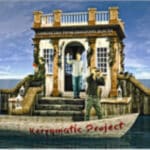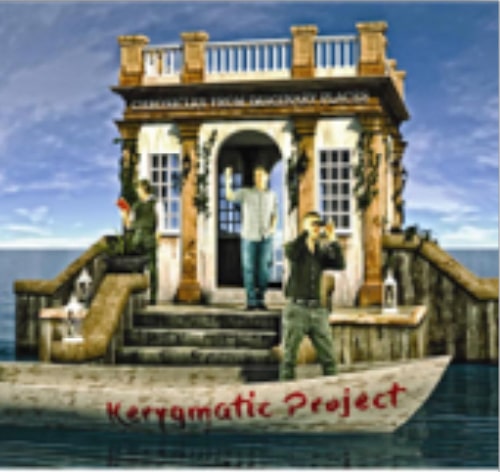Chronicles from imaginary places is certainly the album of the artistic maturity of the Kerygmatic Project
band. This is a well-structured, fresh and dynamic work, in which, besides some well-made pieces, there
are three powerful suites. The basic idea behind the various compositions is that of traveling in the
artistic imagination. A time machine that allows you to travel between present, past and future, through
everyday reality to that contemplated by creative imagination. Classicism and romance are brilliantly
mixed, contributing to the unity of the album to a really intense, deep and extraordinarily elaborate
album, even in its full listener.
1. The Time Machine – Part I, II, III (words and music by S. Tadini, M. Campagnolo, D. Nobili). The opening suite marks
the beginning of an imaginary journey. The time machine is ready, no more time to go back, the future is already present. The Part I, structured
on the roots of a very exciting prog rock, introduces the theme of the imaginary journey through dreams, leaving space for Part II, which is
definitely intense, lyrical and concretely filled with literary references related to The Waste Land composition by T. S. Eliot. Contemporary
man, in balance between anguish and hope, is asked: is madness a new horizon, or is still there a space to hope for? Part III, in the end, leaves
the sounds of prog and pop refined to come to jazz. A young, unnamed protagonist, is to be chosen to occupy an apical position in a sort of
imaginary company, where, as long as there is no demand for it, it has the potential to enrich itself beyond any measure and to even reach the
point of driving a stupid and easily corrupted nation. The protagonist chooses to flee. He overcomes his morality and tries to reach his time
machine to get away from that place, but it is too late now; he is part of an unmistakable mechanism.
2. Chronicles from Imaginary Places (words and music by S. Tadini, M. Campagnolo, D. Nobili). This song is inspired by the
desire of redemption. It is the call of conscience to fight always, because in the midst of every situation true love will never be defeated. A
chronicle from an imaginary place made of recognizable and other just evoked elements, where consciousness realizes that must always get
involved, risking everything, because an angel will always be at his side and love, the true one, has already won.
3. Footprints in the Sand of Time (words and music by S. Tadini, M. Campagnolo, D. Nobili). The quietest place on earth, a
kind of earthly paradise, can turn into a nightmare, in a storm. When the senses seem to be fallacious and the doubts over everything
overwhelm the reason, when the beloved woman has vanished and there are only the footprints left on the sand of time, everything seems to
have the bitter taste of a memory made of tears, yet there is hope for a new encounter, a new life, in which the two lovers can be one, even in
the sand of time.
4. Escaping from Seventh Prison (music by D. Nobili). This instrumental composition expresses the desire for escaping from
the senses, especially from the “seventh”, that is, self-perception.
5. The Brightest Event Horizon – a) Junk Shop Open; b) Junk Shop Closed (words and music by M. Campagnolo).
The central suite of the album is dedicated to an absolutely surreal experience, although its beginning seems perfectly realistic. The protagonist,
traveling along a dusty road in the desert, looking for an unexplored land, comes across a Junk store. Entering the shop, he remains attracted to
everything he sees, as long as a metal pot spells its word and suddenly, the unkempt adventurer, is transformed into a silver spoon, immediately
placed by the junk dealer in a showcase among thousands of other objects.
6. Dive into the Night (words and music by D. Nobili). A sailor, sailing in seas far from home, finds a mermaid on a rock. He
dives into the water to help her, he falls in love, but the two lovers know that their love is impossible. After weeping all night, enjoying the last
kiss, the mermaid dives into the sea and the sailor continues his course. A curious thought in her mind that turns into a cry: “always, always with
you!”
7. The Castle (words and music by S. Tadini). It is a Gothic song. Gloomy landscapes, vampires, werewolves, snakes and other
elements related to the classical tradition of the Gothic novel genre are the background of this composition focused on the disavowal of a
character who tries in vain to save his life.
8. The Clear Side of Darkness (words and music by S. Tadini, M. Campagnolo, D. Nobili). It is the meaningful story of a life
lived in pain and anguish, in which the protagonist expresses his mood without losing hope of a better day, of a reign that will come.
9. Kubla Khan (words by S. T. Coleridge, music by S. Tadini). This unfinished poetic composition, written by Coleridge in 1797,
represents strongly the greatness of poetic imagination, capable of creating unbreakable worlds that overcome the reality in itself. The work,
based on the colourful images depicted by the poet, is a perfect example of a meta-temporal relationship between a poetic composition and a
musical composition. The initial vision of a pleasure dome opens the description of the surrounding landscape, following the vision of an
Abyssinian girl, whom Coleridge complains for not being able to reproduce the song. The typically dreamlike character of the poetic
composition produces a succession of images apparently disconnected from each other, but joined by the power of the poetic imagination of
the author.
***
Chronicles from imaginary places è certamente l’album della maturità artistica dei Kerygmatic Project. Si
tratta di un lavoro ben strutturato, fresco e dinamico, in cui trovano posto, oltre ad alcuni brani ben
riusciti, tre poderose suite. L’idea base che accomuna le varie composizioni è quella del viaggio
nell’immaginazione artistica. Una macchina del tempo che permette di viaggiare tra presente, passato e
futuro, attraverso la realtà quotidiana a quella prospettata dall’immaginazione creativa. Classicità e
romanticismo si mescolano sapientemente, contribuendo a dare unità di fondo ad un album
decisamente intenso, profondo e straordinariamente elaborato, pur nella sua piena ascoltabilità.
1. The Time Machine – Part I, II, III (parole e musica di S. Tadini, M. Campagnolo, D. Nobili). La suite di apertura segna
l’inizio di un viaggio immaginario. La macchina del tempo è pronta, non c’è più tempo per tornare indietro, il futuro è già presente. La parte I,
strutturata sui canoni di un prog rock decisamente avvincente, introduce il tema del viaggio immaginario attraverso i sogni, per poi lasciare
spazio alla parte II, decisamente intensa, lirica e al tempo stesso concreta, ricolma di riferimenti letterari riconducibili alla composizione The
Waste Land di T. S. Eliot. L’uomo contemporaneo, in bilico tra angoscia e speranza, si chiede: la follia è un nuovo orizzonte, oppure c’è
ancora spazio per sperare? La parte III, infine, lascia i suoni del prog e del pop raffinato per giungere al jazz. Un giovane protagonista senza
nome si trova ad essere scelto per occupare una posizione apicale in una sorta di azienda immaginaria, nella quale, a patto che non si faccia
domanda alcuna, ha la possibilità di arricchirsi oltre ogni misura e di poter giungere persino alla guida di una nazione stupida e facilmente
corruttibile. Il protagonista sceglie di fuggire. Ha il sopravvento la sua moralità e tenta di raggiungere la sua macchina del tempo per allontanarsi
da quel luogo, ma ormai è troppo tardi: anch’egli è parte di un meccanismo immodificabile.
2. Chronicles from Imaginary Places (parole e musica di S. Tadini, M. Campagnolo, D. Nobili). Questo brano è ispirato al
desiderio di riscatto. È il richiamo della coscienza a combattere sempre, perché in mezzo ad ogni situazione l’amore vero non verrà mai
sconfitto. Una cronaca da un luogo immaginario fatto di elementi riconoscibili ed altri solamente evocati, in cui la coscienza prende atto di
doversi sempre mettere in gioco, rischiando sino in fondo, perché un angelo sarà sempre al suo fianco e l’Amore, quello vero, ha già vinto.
3. Footprints in the Sand of Time (parole e musica di S. Tadini, M. Campagnolo, D. Nobili). Il luogo più tranquillo della terra,
una sorta di paradiso terrestre, può trasformarsi in un incubo, in una tempesta. Quando i sensi sembrano essere fallaci e i dubbi su ogni cosa
prendono il sopravvento sulla ragione, quando la donna amata è scomparsa e ne rimangono solo le impronte lasciate sulla sabbia del tempo,
ogni cosa sembra avere il sapore amaro di un ricordo fatto di lacrime, eppure resta la speranza di un nuovo incontro, di una nuova vita, in cui i
due amanti potranno essere una cosa sola, anche nella sabbia del tempo.
4. Escaping from Seventh Prison (musica di D. Nobili). Questa composizione strumentale esprime il desiderio di una fuga dai
sensi, in particolare dal “settimo”, vale a dire l’autopercezione.
5. The Brightest Event Horizon – a) Junk Shop Open; b) Junk Shop Closed (parole e musica di M. Campagnolo). La
suite centrale dell’album è dedicata ad un’esperienza assolutamente surreale, sebbene il suo inizio appaia perfettamente realistico. Il
protagonista, in viaggio lungo una strada polverosa nel deserto, in cerca di una terra inesplorata, si imbatte in un negozio da rigattiere. Una volta
entrato rimane attratto da tutto ciò che vede, fintanto che una pentola di metallo gli rivolge la parola ed improvvisamente, l’incauto avventore, si
trova trasformato in un cucchiaio d’argento, subito posto dal rigattiere in vetrina fra mille altri oggetti.
6. Dive into the Night (parole e musica di D. Nobili). Un marinaio, navigando in mari lontani da casa, trova una sirena su di una
roccia. Si tuffa in acqua per soccorrerla, se ne innamora, ma i due sanno che il loro amore è impossibile. Dopo aver pianto tutta la notte e aver
gustato l’ultimo bacio, la sirena si tuffa nel mare e il marinaio prosegue la sua rotta. Un pensiero assillante nella sua mente che si trasforma in
un grido: «sempre, sempre con te!».
7. The Castle (parole e musica di S. Tadini). Paesaggi lugubri, vampiri, lupi mannari, serpenti ed altri elementi legati alla tradizione
classica del genere gotico, fanno da sfondo a questa composizione incentrata sulla disavventura di un personaggio che tenta invano di salvare la
vita.
8. The Clear Side of Darkness (parole e musica di S. Tadini, M. Campagnolo, D. Nobili). È il racconto significativo di una vita
vissuta nel dolore e nell’angoscia, in cui il protagonista esprime il proprio stato d’animo senza mai perdere la speranza di un giorno migliore, di
un regno che verrà.
9. Kubla Khan (parole di S. T. Coleridge, musica di S. Tadini). Questa composizione poetica incompiuta, scritta da Coleridge nel
1797, rappresenta con forza la grandezza dell’immaginazione poetica, capace di creare mondi incommensurabili che superano la stessa realtà.
L’opera, messa in musica assecondando le variopinte immagini descritte dal poeta, costituisce un perfetto esempio di relazione metatemporale
fra una composizione poetica e una composizione musicale. L’iniziale visione di un palazzo per il piacere apre la descrizione del paesaggio
circostante, in seguito alla visione di una fanciulla abissina, della quale Coleridge lamenta di non saper riprodurre il canto. Il carattere
tipicamente onirico del componimento poetico produce un susseguirsi di immagini solo apparentemente disconnesse tra loro, poiché unite
dalla forza dell’immaginazione poetica dell’autore.




